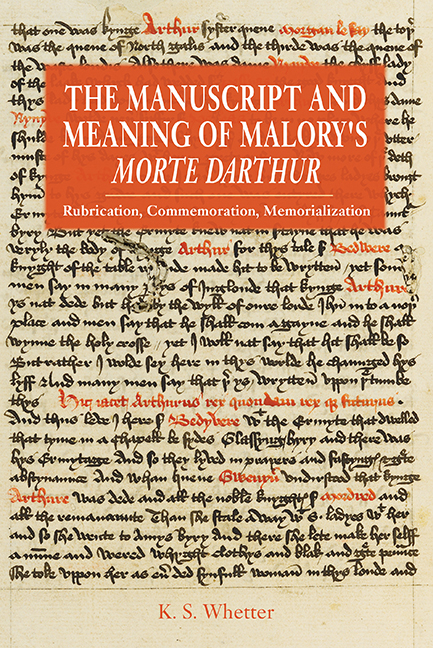Book contents
- Frontmatter
- Dedication
- Contents
- List of Plates
- Acknowledgements
- Abbreviations
- A Note on the Text
- A Textual Introduction
- 1 The Unusual Nature of Winchester's Rubrication
- 2 Tracing Winchester's Rubrication and Marginalia
- 3 Malory's Sacralized Secularity
- 4 Rubricated Elegy
- Conclusion: The Red and the Black
- Bibliography
- Index
- Miscellaneous Endmatter
2 - Tracing Winchester's Rubrication and Marginalia
Published online by Cambridge University Press: 28 April 2017
- Frontmatter
- Dedication
- Contents
- List of Plates
- Acknowledgements
- Abbreviations
- A Note on the Text
- A Textual Introduction
- 1 The Unusual Nature of Winchester's Rubrication
- 2 Tracing Winchester's Rubrication and Marginalia
- 3 Malory's Sacralized Secularity
- 4 Rubricated Elegy
- Conclusion: The Red and the Black
- Bibliography
- Index
- Miscellaneous Endmatter
Summary
When Mador yields himself unto Launcelot and releases Gwenyvere from the charge of treason at the conclusion of the trial by combat to settle Gwenyvere's innocence in Malory's Poisoned Apple episode, Launcelot qualifies the mercy he will grant Mador: ‘I woll nat graunte the thy lyff … only that thou frely release the quene for ever, and that no mencion be made uppon Sir Patryseys tombe that ever Quene Gwenyvere consented to that treson’ (415v; 801.30–3; my emphasis). Launcelot's awareness of the positive and negative memorial potential of monuments in the Morte Darthur, especially engraved tombs, is not unique. Many other occasions in the Morte record writing on tombs and the memorial and elegiac possibilities of inscribed messages. In this case, however, Launcelot's concern with the memorial force of the written word is original to Malory. What I hope to reveal in the current book is the extent to which this same memorial and elegiac use of writing occurs not only in Malory's lexical text (the words of the story), but in the manuscript or codicological text as well. The rubrication of knights’ and ladies’ names throughout the Winchester manuscript, together with the marginalia announcing various deeds, is the codicological equivalent to the many inscribed tombs and chivalric records within Malory's Morte Darthur itself. Just as Launcelot is concerned that Gwenyvere not be dishonoured by a false memorial, so Winchester's rubrication and marginalia serve both to memorialize and glorify the knights and deeds and loves of the Round Table. The Winchestermanuscript version of the Morte, that is, creates a rubricated testimonial to Arthur and his knights, celebrating the glory and lamenting the tragedy of ‘The Hoole Book of Kyng Arthur and of His Noble Knyghtes of the Rounde Table, that whan They were Holé Togyders there was ever an Hondrede and Fyfty’ (C XXI.13; MD 940.17–19).
As the Poisoned Apple episode reveals, Malory's narrative style throughout the Morte Darthur is largely unobtrusive. The result, as P. J. C. Field convincingly demonstrates, is that the audience's or reader's focus is drawn all the more to those voices we do hear: the characters themselves.Characterization was, in fact, an obvious concern of Malory's, for he goes out of his way to people his narrative with a recognizable and familiar cast, even giving names to minor characters who are not named in the sources.
- Type
- Chapter
- Information
- The Manuscript and Meaning of Malory's Morte DarthurRubrication, Commemoration, Memorialization, pp. 66 - 116Publisher: Boydell & BrewerPrint publication year: 2017



